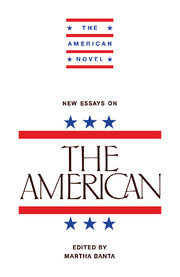1 - Introduction
Published online by Cambridge University Press: 06 July 2010
Summary
WHEN Henry James began work on The American in 1875, he was impelled by three interconnected needs, all to do with finding the “right forms.” He had to give shape to his nascent career by driving it forward in the direction that would best enhance his reputation as a promising young writer; he had to decide what authorial perspective to take on the material he treated in his narrative and whether to guide it toward the literary genre of the romance (locus of the fanciful) or the novel (seat of the realist); he had to define to his own satisfaction what the American character was in relation, first, to the United States, which he perceived as essentially formless, and, second, to a foreign culture whose historical forms were all too rigidly in place.
It was mid-1876 by the time James completed his story of Christopher Newman, the freewheeling American millionaire abroad in the Paris where James had felt himself at odds. While James was busy raising questions about where habits of independence and self-reliance got a man like Newman and pursuing his unofficial exposition of the meaning of “the American,” his compatriots were gathering back home in Philadelphia to celebrate the one-hundredth anniversary of the nation's severance from the Old World in 1776. Many were responding with patriotic pride to the lavishly stocked exhibition halls of the 1876 centennial, which appeared to give credence to the belief that the United States had come very far very fast over the past century – as a growing political power, as the catalyst for astonishing technological achievements, and as the champion of a democratic culture.
- Type
- Chapter
- Information
- New Essays on The American , pp. 1 - 42Publisher: Cambridge University PressPrint publication year: 1987



